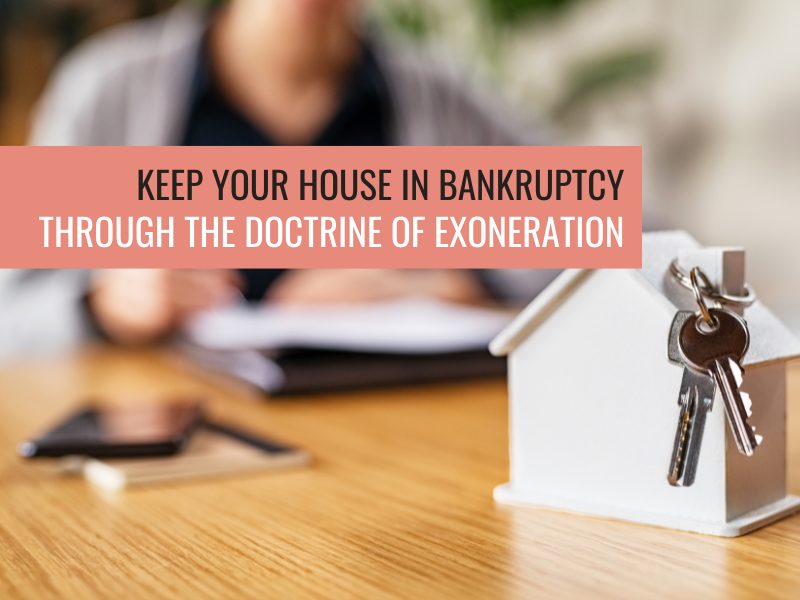
One of the major concerns when a spouse is made a bankrupt is what will happen to the family home. And many people are justifiably worried that they will lose their home once their partner is made bankrupt.
In this article, we discuss how the equitable doctrine of exoneration may help save your family home in the event your partner goes bankrupt.
What is the doctrine of exoneration?
The doctrine of exoneration is a presumption that affords protection to a spouse where their partner had taken a loan against a property for their sole benefit e.g. a business loan. In such a case, the doctrine dictates that the spouse who has taken out the loan should be the party responsible for the loan, and any repayment should first be taken from his or her share of the property.
How will it apply if a partner goes bankrupt?
In a bankruptcy, the appointed Bankruptcy Trustee’s duty is to realise all assets of a bankrupt to repay the bankrupt’s creditors. If the bankrupt has an interest in a property and the property has sufficient equity, the Trustee will take steps to sell the property.
In a typical scenario, a couple would have purchased a property together in joint names. The purchase would have been funded by a mortgage secured by the property. Below is an example where the couple owns a house worth $1 million and there is a $500,000 remaining unpaid under the mortgage. Both partners own half of the property each.
Upon bankruptcy of one of the partners, say the husband, the Bankruptcy Trustee will take steps to sell the property, repay the mortgage, and pay the wife her share of equity, which is $250,000. The husband’s share of $250,000 will be applied towards repaying creditors.
Example
|
|
Husband (Bankrupt) |
Wife |
|
Share |
$500,000 |
$500,000 |
|
Home Loan |
($250,000) |
($250,000) |
|
Equity |
$250,000 |
$250,000 |
How does the doctrine of exoneration apply in real life, and in particular where a partner is declared a bankrupt? In this article, we look at 3 common scenarios.
Scenario 1
Scenario 1 is where no mortgage was taken out to purchase the family property, or that the mortgage has been fully repaid. However, let’s assume a $500,000 loan was then taken out against the property. The loan is a business loan taken by the husband and was used solely by the husband to start his business. The wife was not involved in his business and did not benefit from the loan.
In this scenario, the doctrine of exoneration dictates that the business loan should be paid from the husband’s share of the property once he is a bankrupt. Assuming that the value of the property is $1 million, the husband’s equity will be $500,000 and is enough only to fully repay the business loan.
In such a scenario, a Bankruptcy Trustee will not take steps to sell the property as there will be no surplus funds from the sale of the bankrupt’s share to repay creditors.
|
|
Husband (Bankrupt) |
Wife |
|
Share |
$500,000 |
$500,000 |
|
Business Loan |
($500,000) |
0 |
|
Equity |
0 |
$500,000 |
Scenario 2
Scenario 2 has the property valued at $1 million with a $600,000 mortgage. The husband took out a business loan of $250,000 against the property for his business. The wife, like the previous scenario, did not benefit from the business loan.
With the doctrine of exoneration applied, the husband share of the property will be used to repay half of the mortgage ($300,000) and the business loan upon bankruptcy. In this case, there is shortfall of $50,000 in which the wife will be responsible for.
Practically however, the trustee will not take steps to sell the property as there is negative equity on the bankrupt’s share. However, it would be a good idea in these circumstances for the wife to make some offer to buy the husband’s interest in the property as if the equity in his interest increases then this may create equity which the bankruptcy trustee may seek to realise.
|
|
Husband (Bankrupt) |
Wife |
|
Share |
$500,000 |
$500,000 |
|
Home Loan |
($300,000) |
($300,000) |
|
Business Loan |
($250,000) |
0 |
|
Equity |
($50,000) |
$250,000 |
Scenario 3
In this scenario, let’s assume the couple borrowed $600,000 to purchase the property and it is valued at $1 million. The husband then took out another loan of $150,000 for his business.
In this scenario, the husband will be left with $50,000 in equity and the wife $250,000, as follows.
|
|
Husband (Bankrupt) |
Wife |
|
Share |
$500,000 |
$500,000 |
|
Home Loan |
($300,000) |
($300,000) |
|
Business Loan |
($150,000) |
0 |
|
Equity |
$50,000 |
$250,000 |
In the real world, selling a property involves substantial costs. As such, the husband’s equity may be less than $50,000. In this situation, the wife may negotiate and come to an agreement with the Bankruptcy Trustee to purchase the husband’s equity for a reasonable amount taking into account the value of the equity and some selling costs.
How We Can Help
The scenarios provided above are a simplification of how the doctrine of exoneration works. Whether it applies to you will depend on the circumstances of your case. Certain conditions must be met to rely on the doctrine. Many families have also structured their business around a family trust and this does make things more complicated in trying to rely on the doctrine of exoneration.
If you are thinking of bankruptcy but is unsure whether your family home is at risk, speak to a professional at Pearce & Heers. Contact us at our Brisbane or Gold Coast offices for a free no-obligation consultation to better understand how this may apply to you.

